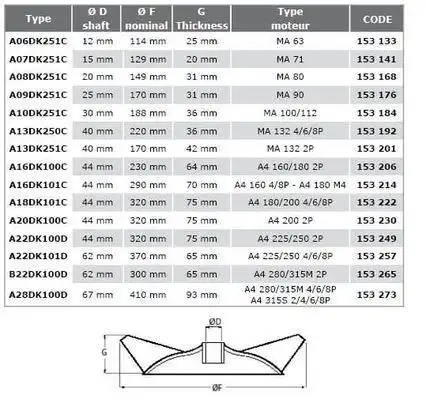Motor Cooling Fan Size Chart | Everything You Need to Know
Efficient cooling is essential for the proper functioning and longevity of electric motors. Electric motors generate heat during operation, and if this heat is not adequately dissipated, it can lead to reduced performance and even motor failure.
To ensure optimal cooling, motor cooling fans are often employed, and choosing the right fan size is crucial. A motor cooling fan size chart can be a valuable tool for engineers and maintenance professionals to make informed decisions about which fan size to use for a particular motor.

What Does You Think About Motor Cooling Fans?
Motor cooling fans are designed to dissipate heat from electric motors, ensuring they operate within their specified temperature limits. Excessive heat can cause insulation damage, bearing failure, and decreased motor efficiency. To mitigate these issues, cooling fans are installed on motor housings or enclosures.
Motor cooling fans work on the principle of forced convection, where they circulate ambient air to remove heat generated by the motor. The size and efficiency of the cooling fan significantly impact its cooling capacity.
The motor cooling fan size chart helps in selecting the most appropriate fan size by considering various factors, such as motor power, speed, and operating conditions.
Size Chart of Motor Cooling Fan

Size Chart of Motor Cooling Fan
Choosing the Right Fan Size
Using the motor cooling fan size chart, engineers and technicians can determine the appropriate fan size for a specific motor. To make the right choice, follow these steps:
1. Identify Motor Specifications
Begin by gathering information about the motor’s power rating, operating speed, and ambient temperature. Make sure you know the type of enclosure in which the motor is housed.
2. Consult the Chart
Locate the motor power rating and operating speed on the chart. Check the ambient temperature to see which fan size is recommended.
3. Consider Additional Factors
In some cases, you may need to account for other factors like altitude, humidity, and the need for redundancy. These can influence the choice of fan size.
4. Evaluate Noise and Space Constraints
If noise and space are concerns, choose a fan that meets these requirements without compromising cooling effectiveness.
5. Installation and Maintenance
Proper installation and regular maintenance of cooling fans are crucial for their effectiveness. Follow the manufacturer’s guidelines for installation and cleaning to ensure optimal performance.
Factors Affecting Motor Cooling Fan Size
The size of a motor cooling fan is crucial for ensuring that the motor operates within its optimal temperature range. An appropriately sized fan can effectively dissipate the heat generated by the motor during its operation, preventing overheating and potential damage. Several factors influence the size of a motor cooling fan:
1. Motor Power Rating
– Higher power-rated motors tend to generate more heat during operation. Therefore, they require larger or more efficient cooling fans to dissipate the heat effectively.
2. Duty Cycle
– Motors that operate continuously or under heavy loads for extended periods will generate more heat compared to those that operate intermittently. Such motors require better cooling solutions.
3. Ambient Temperature
– In environments with higher ambient temperatures, the motor may require a larger or more efficient fan to ensure adequate cooling.
4. Motor Design
– Some motors are designed to operate at higher temperatures, while others are not. The design and materials used in the motor can influence its cooling requirements.
5. Enclosure Type
– Enclosed motors may require more aggressive cooling solutions compared to open motors since the heat dissipation in enclosed motors is not as efficient.
6. Installation Location
– Motors installed in confined spaces or areas with limited airflow may require larger fans or additional cooling methods.
7. Operational Speed
– Motors that operate at high speeds tend to generate more heat due to increased friction. This can influence the size of the cooling fan required.
8. Efficiency
– Higher efficiency motors generally produce less waste heat. However, even high-efficiency motors require adequate cooling to ensure longevity and optimal performance.
9. Type of Cooling Medium
– The medium used for cooling, whether it’s air or liquid, can influence the fan size. Liquid cooling systems, for instance, might require different fan configurations than air-cooled systems.
Why Motor Cooling Fan Size Chart Is Essential?
A motor cooling fan size chart is an invaluable tool in various industries, especially in the design, installation, and maintenance of electrical and mechanical systems that rely on motors.
The chart provides information about the appropriate size of cooling fans needed to dissipate heat efficiently and maintain the optimal operating temperature of motors.
1. Efficient Heat Dissipation
The primary purpose of a motor cooling fan is to dissipate heat generated during the operation of motors. If the fan is too small for the application, it will struggle to adequately cool the motor.
Conversely, an oversized fan may be unnecessary and can lead to increased energy consumption and noise. A size chart helps ensure that the right-sized fan is selected, promoting efficient heat dissipation.
2. Optimal Motor Performance
Motors are designed to operate within specific temperature ranges to achieve their best performance. When motors run too hot, their efficiency decreases, and they may experience reduced output or even damage.
A properly sized cooling fan, as determined by the chart, helps maintain the motor’s temperature within the desired range, resulting in optimal performance.
3. Energy Efficiency
Choosing the right-sized cooling fan based on the size chart can lead to energy savings. An oversized fan may draw more power than necessary, contributing to higher operational costs.
In contrast, an undersized fan may struggle to maintain the desired temperature, potentially leading to reduced motor efficiency and increased energy consumption.
4. Longevity of Motors
Motors that operate within their specified temperature range tend to have longer lifespans. Consistently high temperatures can cause accelerated wear and tear on motor components, resulting in more frequent maintenance and shorter operational lifetimes. A properly sized fan, guided by the size chart, helps extend the lifespan of motors.
5. Cost Savings
By preventing overheating and extending the lifespan of motors, a well-chosen cooling fan can result in cost savings. Reduced maintenance and replacement costs, as well as improved energy efficiency, contribute to a more cost-effective operation.
6. Safety Considerations
In certain applications, such as industrial settings, an overheating motor can pose safety risks, including fire hazards. The use of a size chart to select an appropriately sized cooling fan ensures the motor operates safely, mitigating the risk of accidents or damage to equipment.
7. Application Specificity
Different motor applications have varying cooling requirements. A size chart can take into account factors like motor size, power output, environmental conditions, and duty cycles to recommend the right fan size for the specific application, ensuring a tailored solution.
8. Preventing Noise Pollution
Oversized fans can generate excess noise, which may be undesirable in certain settings. A properly sized fan, determined using the size chart, helps maintain an appropriate balance between cooling capacity and noise levels.
9. Ease of Selection
A size chart simplifies the process of selecting the appropriate cooling fan. Instead of relying on trial and error or complex calculations, engineers and technicians can refer to the chart to make an informed decision quickly.
10. Technology Advancements
As technology advances, cooling fan designs become more sophisticated. Modern fans often come with smart controls and sensors that can be integrated into systems to optimize their performance. A size chart provides a reference point for selecting fans with these advanced features.
Frequently Asked Questions
What safety precautions should I take when working with motor cooling fans?
Safety measures include disconnecting power sources, using appropriate personal protective equipment, and following installation and maintenance guidelines provided by the manufacturer.
Is it possible to oversize a motor cooling fan?
Oversizing a fan may be wasteful in terms of energy consumption and can disrupt the motor’s operating conditions. It’s best to match the fan size closely to the requirements.
Conclusion
A motor cooling fan size chart is a valuable resource for those responsible for the maintenance and operation of electric motors. Choosing the right fan size is essential to prevent overheating and ensure the long-term reliability of the motor.
Subscribe to our newsletter
& plug into
the world of circuits